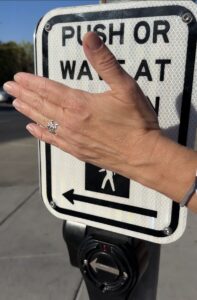

The Utah Department of Transportation (UDOT) is making the pedestrian experience on the main roadways around the U campus safer by installing accessible pedestrian signal (APS) technology at crosswalks.
“This new crosswalk technology benefits everyone by facilitating safe and independent movement through pedestrian networks regardless of age or ability,” said Mike Blanchette, UDOT traffic engineer.
Utah is among the first in the nation to implement widespread use of these radar-enabled crosswalk buttons that, once triggered, alert pedestrians through an audio feature. This function includes statements like “wait” and “walk sign is on” to keep pedestrians informed.

APS technology utilizes three ways to activate the crosswalk. One is with motion-activated radar where movement, such as motion or waving, will activate the crossing because, “people either don’t feel comfortable touching the buttons, or maybe they’re disabled and they can’t actually reach up and push the button,” continued Blanchette. The crosswalk buttons also operate in the traditional way by pushing the physical button.
Finally, pedestrians can use PedApp on their phone to geolocate their position and activate the crosswalk. The app can trigger a beeping locator tone to help pedestrians orient themselves with the crosswalks and provide audible messages telling them to wait or cross the road. The app also provides pedestrians with live, supplemental information at crosswalks, such as the amount of walking time remaining or the street name and direction they’re heading.
“Currently, we have more than 1000 of these buttons deployed statewide,” said Blanchette. “Our goal within the next 10 years is to have them deployed on all state-controlled routes across the state of Utah.”
There are currently seven APS crosswalks on the U campus with two additional planned.

Equipment costs approximately $7,000 per intersection with four hours of man time to install. UDOT has allocated $800,000 per year for the purchase and deployment of APS buttons. “So it’ll take us about eight or nine more years to fully outfit the remainder of the state with these buttons,” concluded Blanchette.
